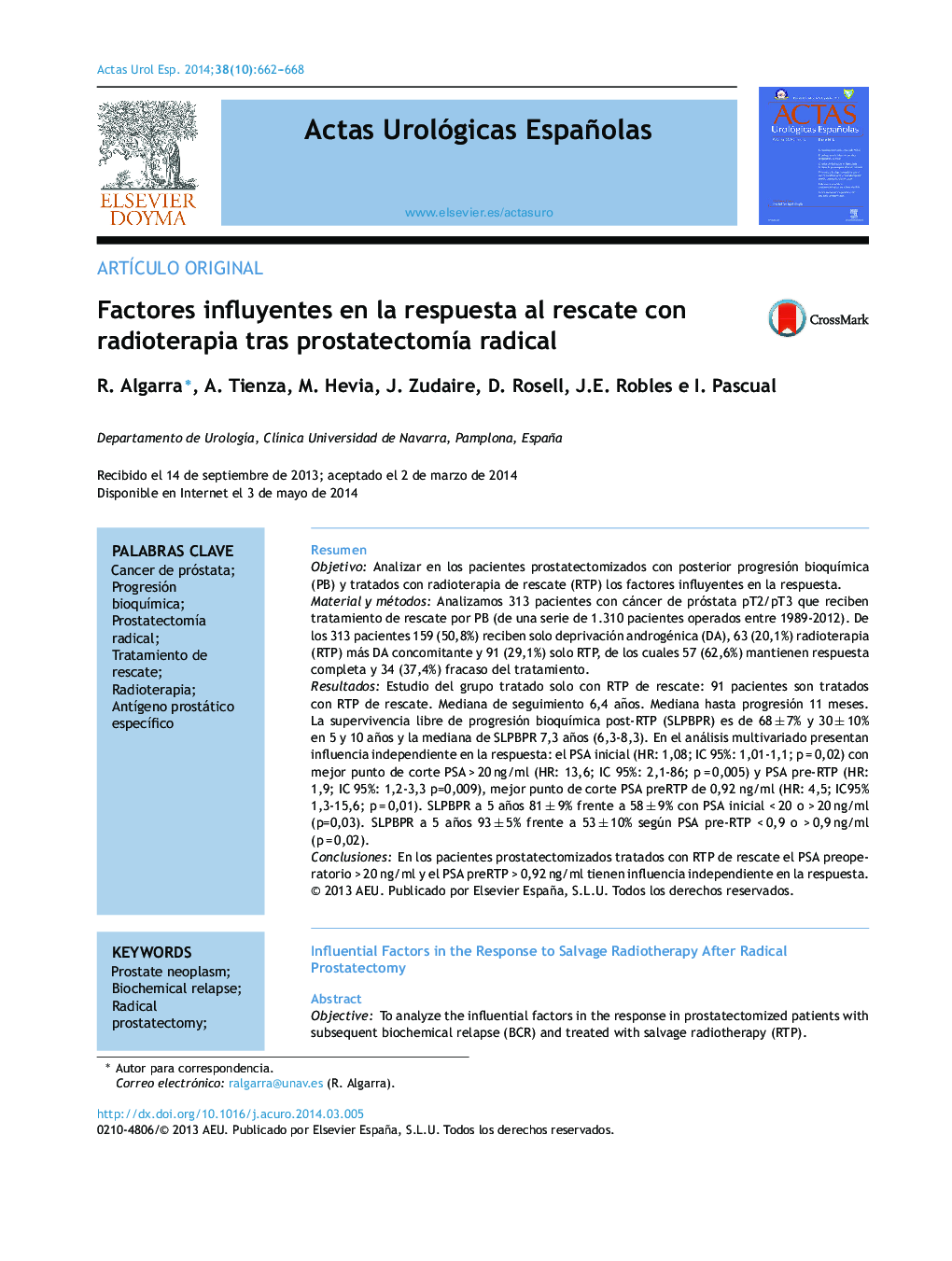| کد مقاله | کد نشریه | سال انتشار | مقاله انگلیسی | نسخه تمام متن |
|---|---|---|---|---|
| 3843314 | 1248091 | 2014 | 7 صفحه PDF | دانلود رایگان |
ResumenObjetivoAnalizar en los pacientes prostatectomizados con posterior progresión bioquímica (PB) y tratados con radioterapia de rescate (RTP) los factores influyentes en la respuesta.Material y métodosAnalizamos 313 pacientes con cáncer de próstata pT2/pT3 que reciben tratamiento de rescate por PB (de una serie de 1.310 pacientes operados entre 1989-2012). De los 313 pacientes 159 (50,8%) reciben solo deprivación androgénica (DA), 63 (20,1%) radioterapia (RTP) más DA concomitante y 91 (29,1%) solo RTP, de los cuales 57 (62,6%) mantienen respuesta completa y 34 (37,4%) fracaso del tratamiento.ResultadosEstudio del grupo tratado solo con RTP de rescate: 91 pacientes son tratados con RTP de rescate. Mediana de seguimiento 6,4 años. Mediana hasta progresión 11 meses. La supervivencia libre de progresión bioquímica post-RTP (SLPBPR) es de 68 ± 7% y 30 ± 10% en 5 y 10 años y la mediana de SLPBPR 7,3 años (6,3-8,3). En el análisis multivariado presentan influencia independiente en la respuesta: el PSA inicial (HR: 1,08; IC 95%: 1,01-1,1; p = 0,02) con mejor punto de corte PSA > 20 ng/ml (HR: 13,6; IC 95%: 2,1-86; p = 0,005) y PSA pre-RTP (HR: 1,9; IC 95%: 1,2-3,3 p=0,009), mejor punto de corte PSA preRTP de 0,92 ng/ml (HR: 4,5; IC95% 1,3-15,6; p = 0,01). SLPBPR a 5 años 81 ± 9% frente a 58 ± 9% con PSA inicial < 20 o > 20 ng/ml (p=0,03). SLPBPR a 5 años 93 ± 5% frente a 53 ± 10% según PSA pre-RTP < 0,9 o > 0,9 ng/ml (p = 0,02).ConclusionesEn los pacientes prostatectomizados tratados con RTP de rescate el PSA preoperatorio > 20 ng/ml y el PSA preRTP > 0,92 ng/ml tienen influencia independiente en la respuesta.
ObjectiveTo analyze the influential factors in the response in prostatectomized patients with subsequent biochemical relapse (BCR) and treated with salvage radiotherapy (RTP).Material and methodsWe analyzed 313 patients with pT2/pT3 prostate cancer who were receiving salvage therapy due to biochemical relapse (from a series of 1,310 radical prostatectomies between 1989-2012). Of the 313 patients; 159 (50.8%) only received androgen deprivation (AD), 63 (20.1%) Radiotherapy (RTP) plus concomitant AD and 91 (29.1%) only RTP. Of these, 57 (62.6%) have maintained complete response and 34 (37.4%) had failure response with post-RTP BCR.ResultsStudy of the group treated exclusively with salvage RTP. Ninety-one patients were treated with salvage RTP. Median follow-up was 6.4 years and median to recurrence 11 months. Post-RTP biochemical relapse-free survival (PRBRFS) was 68 ± 7% and 30 ± 10% in 5 to 10 years. Median PRBRFS was 7.3 years (6.3-8.3). Initial PSA (HR: 1.08; 95% CI: 1.01-1.1 P = .02) with best PSA cut-off point PSA > 20 ng/ml (HR: 13.6; 95% CI: 2.1-86 P = .005) and PSA pre-RTP (HR: 1.9; 95% CI: 1.2-3.3; P = .009), best PSA cut-off point PSA preRTP 0.92 ng/ml (HR: 4.5; 95% CI: 1.3-15.6; P = .01) showed independent influence in the response in the multivariate study. PRBRFS at 5 years, 81 ± 9% versus 58 ± 9% with initial PSA < 20 or > 20 ng/ml (P = .03). PRBRFS at 5 years, 93 ± 5% versus 53 ± 10% according to PSA pre-RTP < 0.9 or > 0.9 ng/ml (P = .02).ConclusionsIn patients treated with salvage RTP after radical prostatectomy, the preoperative PSA > 20 ng/ml and PSA preRTP > 0.92 ng/ml shows an independent influence on the response.
Journal: Actas Urológicas Españolas - Volume 38, Issue 10, December 2014, Pages 662–668
